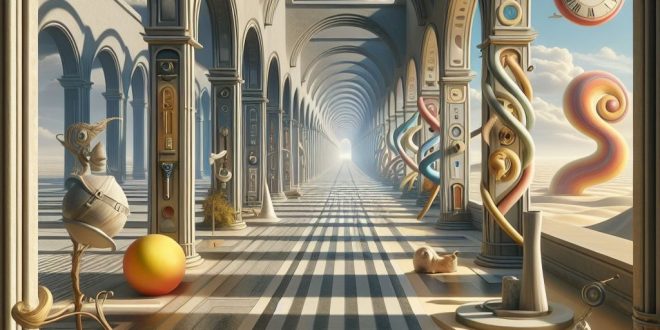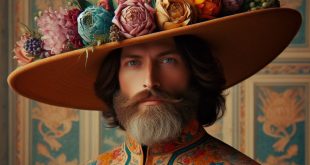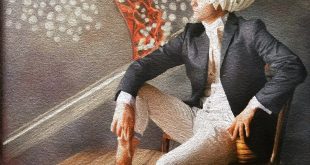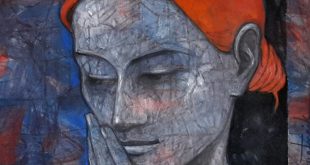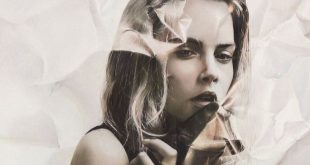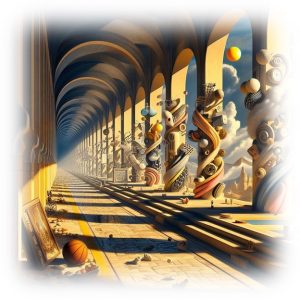 Paul Klee and the art of making visible what is not always visible
Paul Klee and the art of making visible what is not always visible
Among its main exponents, you find André Breton, Salvador Dali, René Magritte, Luis Buñuel and Federico Fellini. Their surreal worlds were condensed into anything that transcended sensible reality, the world of the unconscious and the dream, the absurd or the incredible. That way of nurturing the opportunities of art and literature was born in Paris in the 1920s. Each of them has a unique style and personality, therefore, it is not easy to establish who is the strangest among the surrealist painters https://www.ranker.com/list/famous-surrealism-artists/reference who are part of the artistic movement and literary that wants to express irrational realities to reveal the profound aspects of the psyche. Using different techniques and sources of inspiration, each of them was able to create truly bizarre images. Forerunner of surrealism, with architecture, shadows and mannequins that evoked a sense of the absurd and unreal, Giorgio de Chirico created mysterious and disturbing atmospheres. We can also mention René Magritte, common objects placed in an unusual context, as well as his ability to mix elements of surprise, irony and contradiction. Setting up apocalyptic scenes and featuring the protagonists of an illogical world, Max Ernst, investigating the subconscious, even used collage, frottage and grating techniques to create. Expressing the alterations of truth with colors, with cunning and subtlety of argument, Yves Tanguy identified the colors of solitude, emptiness and impotence, representing landscapes full of abstract forms. Using symbolism and abstract imagery, the imaginative and eccentric Salvador Dali even took to painting clocks, elephants and eggs.
 He experimented with the art of living and the search for the ideal profession, he juggled with poetry and philosophy, but the plastic arts were his real occupation. He was born in Münchenbuchsee, Switzerland. His works are imbued with humor and childishness, as are his moods of personal beliefs and musicality. Together with the Russian painter Wassily Kandinsky, he taught at the Bauhaus school of art, design and architecture https://mymodernmet.com/what-is-bauhaus-art-movement/. His lectures on the theory of form and design are as important to modern art as Leonardo da Vinci’s Treatise on Renaissance Painting. Paul Klee, the Swiss artist with a supremely individualistic style, was influenced by expressionism, cubism and surrealism. A designer who combined freshness, genuineness and spontaneity, he explored the theory of colors. In his early years, he concentrated on becoming a musician, and as he played, he perceived himself emotionally connected to the traditional works of the 18th and 19th centuries. During his adolescence, however, wanting to experience the freedom to explore radical ideas and styles, he preferred to devote himself to the visual arts. At sixteen, in fact, he already had considerable skill in drawing landscapes.
He experimented with the art of living and the search for the ideal profession, he juggled with poetry and philosophy, but the plastic arts were his real occupation. He was born in Münchenbuchsee, Switzerland. His works are imbued with humor and childishness, as are his moods of personal beliefs and musicality. Together with the Russian painter Wassily Kandinsky, he taught at the Bauhaus school of art, design and architecture https://mymodernmet.com/what-is-bauhaus-art-movement/. His lectures on the theory of form and design are as important to modern art as Leonardo da Vinci’s Treatise on Renaissance Painting. Paul Klee, the Swiss artist with a supremely individualistic style, was influenced by expressionism, cubism and surrealism. A designer who combined freshness, genuineness and spontaneity, he explored the theory of colors. In his early years, he concentrated on becoming a musician, and as he played, he perceived himself emotionally connected to the traditional works of the 18th and 19th centuries. During his adolescence, however, wanting to experience the freedom to explore radical ideas and styles, he preferred to devote himself to the visual arts. At sixteen, in fact, he already had considerable skill in drawing landscapes.
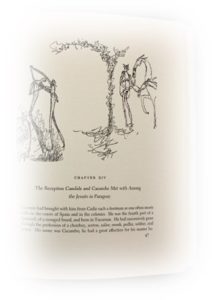 From 1897 to 1918, Paul Klee began writing his own diary which provided scholars with ideas to investigate his thoughts. During his school years, demonstrating skill with lines and volumes, he particularly drew caricatures. In his free time, in addition to his interest in music and art, he also cultivated an interest in literature. He studied art at the Academy of Fine Arts in Munich, but with difficulties related to the use of color. After graduating in Fine Arts, he traveled to Italy, studying the painters of past centuries. In his mind, the use of color seemed to connect optimism, to the hope of relief from a pessimistic nature. Returning to Bern, in 1905 he developed experimental techniques, even drawing with a needle on a blackened sheet of glass. He created a cycle of etchings on zinc sheet, in which he illustrated grotesque characters. In 1906, in Munich he married and had a son with a Bavarian pianist. Dividing his time between domestic matters and the search for a new approach to art, four years later he held his first solo exhibition in Bern. After his meeting with Alfred Kubin, his illustrations of Voltaire’s Candide https://www.guggenheim.org/articles/findings/voltaire-and-paul-klee were published in book form. His inclination towards the absurd and the sarcastic, appreciated by art critics, allowed him to be part of the editorial staff of an almanac founded by Franz Marc and Kandinsky.
From 1897 to 1918, Paul Klee began writing his own diary which provided scholars with ideas to investigate his thoughts. During his school years, demonstrating skill with lines and volumes, he particularly drew caricatures. In his free time, in addition to his interest in music and art, he also cultivated an interest in literature. He studied art at the Academy of Fine Arts in Munich, but with difficulties related to the use of color. After graduating in Fine Arts, he traveled to Italy, studying the painters of past centuries. In his mind, the use of color seemed to connect optimism, to the hope of relief from a pessimistic nature. Returning to Bern, in 1905 he developed experimental techniques, even drawing with a needle on a blackened sheet of glass. He created a cycle of etchings on zinc sheet, in which he illustrated grotesque characters. In 1906, in Munich he married and had a son with a Bavarian pianist. Dividing his time between domestic matters and the search for a new approach to art, four years later he held his first solo exhibition in Bern. After his meeting with Alfred Kubin, his illustrations of Voltaire’s Candide https://www.guggenheim.org/articles/findings/voltaire-and-paul-klee were published in book form. His inclination towards the absurd and the sarcastic, appreciated by art critics, allowed him to be part of the editorial staff of an almanac founded by Franz Marc and Kandinsky.
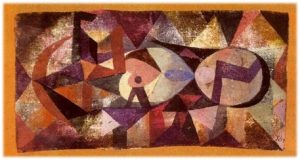 Participation in art exhibitions opened Paul Klee‘s mind to modern color theories. Traveling to Paris, he encountered both cubism and the beginnings of abstract art. He appreciated Robert Delaunay‘s use of color and, using blocks of color with some overlays, developed watercolor experiments with primitive landscapes. 1914, the year he visited Tunisia and was struck by the quality of the light, was the year of his artistic breakthrough. The color took possession of him, he no longer had to chase it, he and the color had become one. So, he began to delve into the romance of abstraction and added color to his drawing skills. After returning home, he painted his first abstract consisting of colored rectangles and some circles. The rectangle became the element that he combined with other colored blocks to create chromatic harmonies similar to those of a musical composition. In 1916 he was drafted as a Prussian soldier; the death of his friends began to affect him to the point that he created lithographs on war themes. When he was sent to an aircraft maintenance company, he carried out the restoration of the aircraft’s camouflage. The following year he was transferred to the Royal Bavarian Flying School in Gersthofen, which allowed him to continue painting. His Ab ovo https://useum.org/artwork/Ab-ovo-Paul-Klee, which produced a rich texture of triangular, circular and crescent motifs, is notable for its watercolor technique on gauze and paper with plaster base.
Participation in art exhibitions opened Paul Klee‘s mind to modern color theories. Traveling to Paris, he encountered both cubism and the beginnings of abstract art. He appreciated Robert Delaunay‘s use of color and, using blocks of color with some overlays, developed watercolor experiments with primitive landscapes. 1914, the year he visited Tunisia and was struck by the quality of the light, was the year of his artistic breakthrough. The color took possession of him, he no longer had to chase it, he and the color had become one. So, he began to delve into the romance of abstraction and added color to his drawing skills. After returning home, he painted his first abstract consisting of colored rectangles and some circles. The rectangle became the element that he combined with other colored blocks to create chromatic harmonies similar to those of a musical composition. In 1916 he was drafted as a Prussian soldier; the death of his friends began to affect him to the point that he created lithographs on war themes. When he was sent to an aircraft maintenance company, he carried out the restoration of the aircraft’s camouflage. The following year he was transferred to the Royal Bavarian Flying School in Gersthofen, which allowed him to continue painting. His Ab ovo https://useum.org/artwork/Ab-ovo-Paul-Klee, which produced a rich texture of triangular, circular and crescent motifs, is notable for its watercolor technique on gauze and paper with plaster base.
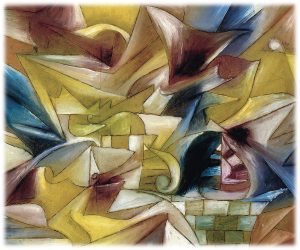 In 1919, he was successful in securing a three-year contract with an art dealer, whose gallery gave Paul Klee exposure and commercial success. A master of form in bookbinding, stained glass and wall painting workshops, he taught at the Bauhaus, welcoming its conflicting theories and opinions. One of his watercolors and oil drawings on paper, Tropical Gardening https://artsandculture.google.com/asset/tropical-garden/qQHYxnQ-nyWPBQ, currently exhibited at the Guggenheim Museum in New York, was born in 1923. With Kandinsky, Lyonel Feininger and Alexej von Jawlensky, was a member of the Blue Four. He held other exhibitions in Paris and was successful among the French Surrealists. In 1929, written by Will Grohmann, a monograph on his work was published. He taught at the Düsseldorf Academy, but was reported by a Nazi newspaper, his house was searched by the Gestapo and he was fired. He had exhibitions in London and met Pablo Picasso, then emigrated to Switzerland with his whole family.
In 1919, he was successful in securing a three-year contract with an art dealer, whose gallery gave Paul Klee exposure and commercial success. A master of form in bookbinding, stained glass and wall painting workshops, he taught at the Bauhaus, welcoming its conflicting theories and opinions. One of his watercolors and oil drawings on paper, Tropical Gardening https://artsandculture.google.com/asset/tropical-garden/qQHYxnQ-nyWPBQ, currently exhibited at the Guggenheim Museum in New York, was born in 1923. With Kandinsky, Lyonel Feininger and Alexej von Jawlensky, was a member of the Blue Four. He held other exhibitions in Paris and was successful among the French Surrealists. In 1929, written by Will Grohmann, a monograph on his work was published. He taught at the Düsseldorf Academy, but was reported by a Nazi newspaper, his house was searched by the Gestapo and he was fired. He had exhibitions in London and met Pablo Picasso, then emigrated to Switzerland with his whole family.
 Ad Parnassum https://www.paulklee.net/ad-parnassum.jsp, his 1932 painting, is considered the best example of his pointillist style. The following year, Paul Klee began experiencing symptoms of scleroderma. His color palettes, bright or dark, reflected his moods. His output in 1936 was 25 works with heavy lines, geometric shapes and larger blocks of color, but by 1939 this had grown to more than 1,200. When he returned to Germany two years later, some of his paintings were included in an exhibition of Degenerate Art, others were seized by the Nazis. In the last months of his life, he created drawings of angels. He died in Switzerland in 1940. He left a legacy comprising 9,000 works of art. If you want to know more about him, you can visit https://www.zpk.org/en/service-navigation/about-us_0/history/the-paul-klee-stiftung-105.html, the official website of the foundation which bears his name. We bring you his last words engraved on his tombstone by his son Felix: Slightly closer to the heart of creation than usual, but still not close enough.
Ad Parnassum https://www.paulklee.net/ad-parnassum.jsp, his 1932 painting, is considered the best example of his pointillist style. The following year, Paul Klee began experiencing symptoms of scleroderma. His color palettes, bright or dark, reflected his moods. His output in 1936 was 25 works with heavy lines, geometric shapes and larger blocks of color, but by 1939 this had grown to more than 1,200. When he returned to Germany two years later, some of his paintings were included in an exhibition of Degenerate Art, others were seized by the Nazis. In the last months of his life, he created drawings of angels. He died in Switzerland in 1940. He left a legacy comprising 9,000 works of art. If you want to know more about him, you can visit https://www.zpk.org/en/service-navigation/about-us_0/history/the-paul-klee-stiftung-105.html, the official website of the foundation which bears his name. We bring you his last words engraved on his tombstone by his son Felix: Slightly closer to the heart of creation than usual, but still not close enough.
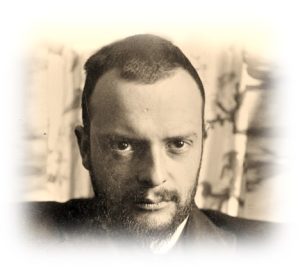 To broaden your horizon of knowledge about other painters, you can type http://meetingbenches.com/category/paintings/. The sole purpose of this site is to spread the knowledge of these artists and that other people enjoy their works. The property of the images that appear in this blog correspond to their authors.
To broaden your horizon of knowledge about other painters, you can type http://meetingbenches.com/category/paintings/. The sole purpose of this site is to spread the knowledge of these artists and that other people enjoy their works. The property of the images that appear in this blog correspond to their authors.
 Meeting Benches World art in all forms
Meeting Benches World art in all forms
